OUT of Space
OUT of Space highlights contributions of the LGBTQ+ community within architecture and the built environment. The exhibition was originally organised by the RIBA LGBTQ+ Community internal group, and the RIBA Library and Collections team for display during LGBT+ History Month 2023.
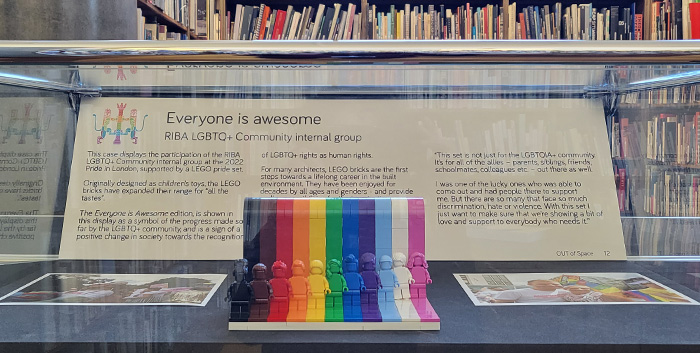
The exhibition presents items from within the collections including books and photographs from architects and clients who designed spaces that expressed (or concealed) their identity.
Out of Space
Out of Space is divided into two sections displaying the relationship between the LGBTQ+ community and architecture throughout history. Starting from the 18th century and ending in the present, this exhibition gives voice to people who are part of the LGBTQ+ community and their way of relating to space.
This includes the relationship between clients and architects, in which the space is shaped with the aim to fulfil the client’s expectations (e.g. Their own home or their workspace); public spaces specifically designed either temporarily or permanently for the LGBTQ+ community; and the appropriation or the spontaneous formation of spaces publicly available but not specifically designed for the LGBTQ+ community (e.g. parks, neighbourhoods or ballroom culture).
As Aaron Betsky asserts in his book Queer space: architecture and same-sex desire, LGBTQ+ people [... ] have always been at the forefront of architectural innovation reclaiming abandoned neighbourhoods, redefining urban spaces, and creating liberating interiors out of hostile environments [... ].
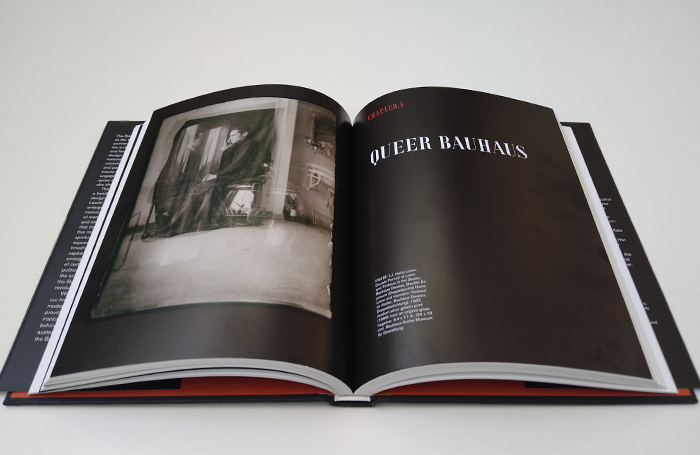
In 1967, male homosexuality was decriminalised in England and Wales, but unfortunately it is still illegal in many parts of the world today. As a result, it is not uncommon for LGBTQ+ people to be careful when choosing whoever is going to provide a service that intervenes into their private sphere.
Quoting Jean Starobinski and borrowing the words of the title of one of his books Portrait of the Artist as an Acrobat [Portrait de l’artiste en saltimbanque], we could easily say that this exhibition is the portrait of LGBTQ+ people as acrobats. Like acrobats who need to find their balance in order not to fall and to move gracefully, queer people need to find their balance in society dodging the prejudices that often surround them.
Out of Space can be interpreted as an architectural short-novel illustrated with items belonging to the RIBA Collections, and displaying the evolution of LGBTQ+ issues in the built environment, from the 18th century to today.
The first section, or chapter, is a monologue reflecting the contributions of the LGBTQ+ community within architecture and the built environment. The second chapter is told by the many voices of the RIBA LGBTQ+ community internal group members and their way of interpreting chosen items from the RIBA Collections. This narrative ends with the participation of the community at the 2022 London Pride parade, together with other LGBTQ+ members from within the field of architecture and the built environment.
Anne Lister and Shibden Hall
Halifax, Yorkshire
Shibden hall was the home of one of the most famous lesbians in British history, Anne Lister (1791-1840). The building dates back to c. 1420, when the property was listed as inhabited by William Otes. For the following two centuries it belonged to various families of the local gentry, until it was passed on to the lister family in 1619. Anne lister inherited Shibden Hall from her uncle and aunt in the 1830s where she lived with her partner Ann Walker until her death in 1840. The couple commissioned Yorkshire architect john harper and landscape gardener Samuel Gray for the design of the most significant overhaul of the estate, with the addition of a tower library and a park.
Charles Robert Ashbee and Cheyne Walk
Chelsea, London
Charles Robert Ashbee (1863-1942) was an architect and key figure in the Arts and Crafts movement, who established the Guild and School of Handicraft. Although he was married to Janet Forbes, he described his love for other men as his guiding light, and was a member of the Order of Chaeronea, an ‘underground’ supportive network for members of the gay community.
Interior spaces in the Arts and Crafts movement, such as Ashbee’s family home in Cheyne Walk have been described as sites of sexual freedom, where respectable domestic life intersected with homosexual fellowship.
Sissinghurst Castle
Sissinghurst in the Weald, Kent
The acclaimed writer and garden designer Vita Sackville-West (1892-1962) had an open marriage with her husband, diplomat Harold Nicholson (1886-1968), and both counted same-sex partners among their lovers.
Sissinghurst Castle in Kent was the backdrop to some of these romances, and its garden design was the creative product of many years of collaboration between the married couple. The RIBA Collections also has a series of sketched designs by Edwin Lutyens for the dolls’ house he designed for Queen Mary. Sackville-West wrote a miniature book titled A Note of Explanation for the dolls’ house, the text of which is thought to have inspired Orlando by Virginia Woolf, with whom Sackville-West had a relationship.
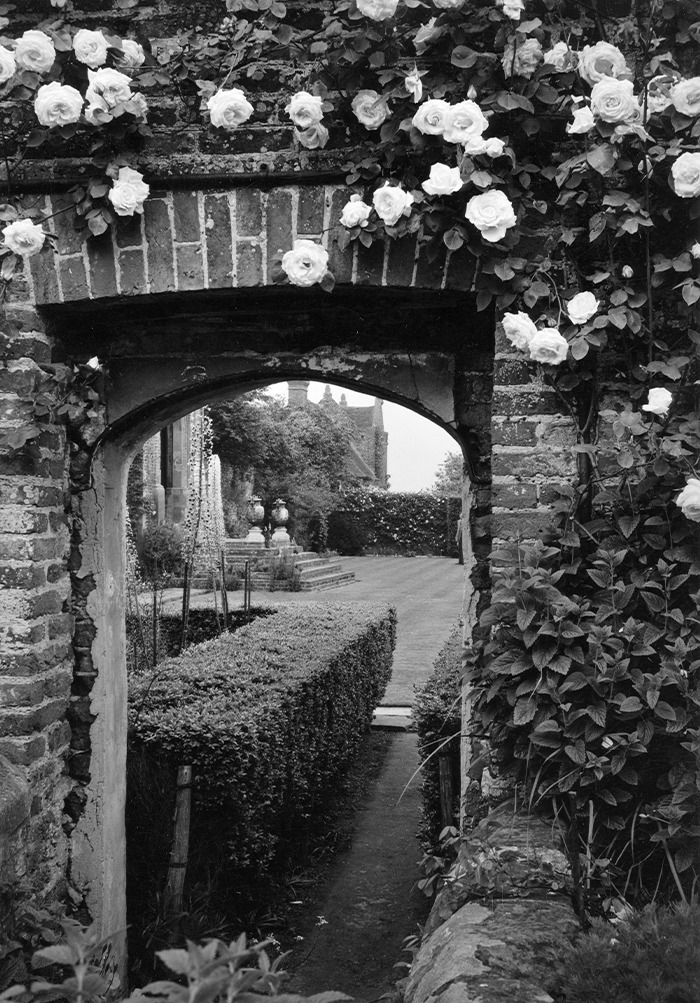
Gluck and Bolton House
Hampstead, London
Gluck (1895-1978) was a gender fluid artist, born Hannah Gluckstein, who commissioned architect Edward Maufe to design an artist’s studio at Bolton House in Hampstead, London. The studio was a key site for the formation of Gluck’s queer identity, where ‘Medallion’, a famous self-portrait with lover Nesta Obermer, was painted.
The Partners, Seely & Paget
Cloth Fair, City of London
John Seely (1868-1947) and Paul Paget (1901-1985) were a 20th century architectural partnership probably best known for transforming Eltham Palace for the Courtauld family in the 1930s.
Seely and Paget are widely understood to have had a romantic, as well as professional relationship. They lived and worked together at 41 Cloth Fair, a 17th century merchant’s house in London that they restored and modernised. One of the design features they introduced was a bathroom adapted to include twin baths so that they could bathe at the same time.
Learn more about Seely & Paget.
Philip Johnson’s Glass House
New Canaan, Connecitcut
American architect Philip Johnson (1906-2005) came out publicly as gay in 1993 and was considered the best-known openly gay architect in the United States at the time. The Glass House was Johnson’s own residence in New Canaan, Connecticut, built to his designs between 1948 and 1949 and since regarded by some historians as a “safe place where gay people could hide in plain sight”.
Max Clendinning and Alwyne Road
Islington, London
Architect, interior and furniture designer, sculptor, and artist Max Clendinning (1924-2020) was one of the most enigmatic and intuitive creators of the British post-war modern movement.
Born in Richhill, County Armagh in Northern Ireland, the son of a furniture manufacturer, Max Clendinning moved to London in the 1950s to complete his architectural studies.
After some travelling Max returned to London where he lived with his partner, theatrical designer Ralph Adron, until his death. The couple moved into Alwyne Road in the 1970s, turning the Victorian interior into a laboratory of ideas - shelves crowded with Cubist-style sculptures and furniture in blazing reds and yellows.
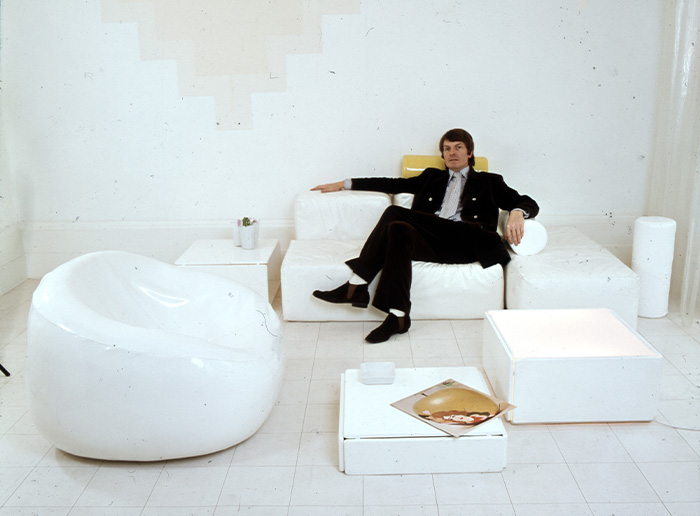
As part of the OUT of Space, members of the internal RIBA LGBTQ+ Community group chose items from the RIBA Collections to explore what the architecture of the item means to them and the wider idea of LGBTQ+ spaces.
Plas Newydd and the ladies of Llangollen
Internal RIBA LGBTQ+ Community member – Emily J.
Choosing to abandon conventional lives in their native Ireland, Lady Eleanor Butler (1739-1829) and Sarah Ponsonby (1755-1831) bought a small cottage together near Llangollen, Wales where they lived as an intimate couple for their entire lives.
Known as the ‘The Ladies of Llangollen,’ Eleanor and Sarah redecorated Plas Newydd (‘new mansion’ in Welsh) in the Gothic style between 1780 and 1829. Here, they hosted guests such as William Wordsworth, Percy Shelley, and Anne Lister who was no stranger to sapphic social circles.
Despite women of this period often openly expressing affection for one another, the pair are thought to have been more than friends as they never married and spent the rest of their lives together.
Expressions of love have never been bound by gender or sexual identity and Plas Newydd serves as a perfect example of how four walls can provide a space for endless possibilities when it comes to female relationships.
Read more about Plas Newydd in our Revisiting the Collections blog about the Ladies of Llangollen.
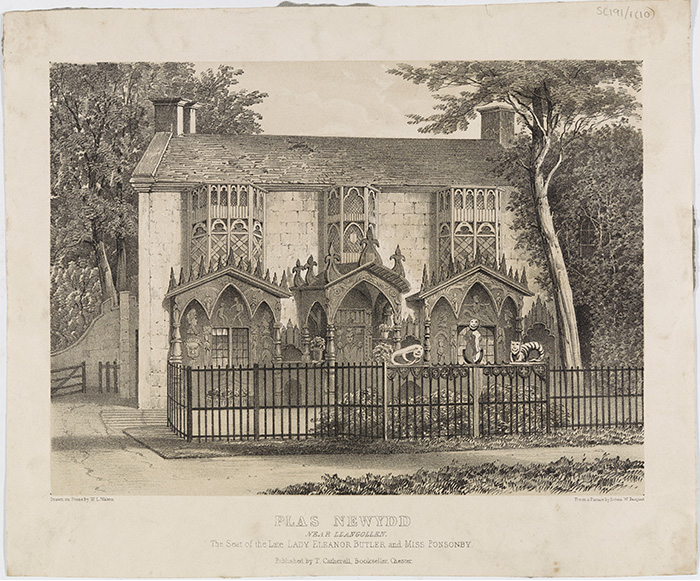
St. Ann’s Court – a house for two bachelors
Internal RIBA LGBTQ+ Community member – Charles H.
Raymond McGrath trained in Sydney before moving to England where he set up an office in 1930. He was very quickly noticed for his modernist designs and his adventurous use of materials. Like-minded friends included Serge Chermayeff (1900-1996), a key architect in the development of British modernism in the 1930s, and Christopher Tunnard (1910-1979), a Canadian-born garden designer interested in avant-garde art and architecture, who had designed a garden for Chermayeff.
When McGrath was commissioned by the wealthy stockbroker Gerald Schlesinger (1890-1966) to design a new house for him in a 18th century landscape garden, he asked Tunnard to modify the garden. Schlesinger and Tunnard became a couple, a development that radically informed the design of the house. Since 1888, sex between men had been illegal even when practiced in private and so for his friends, McGrath designed a house that enabled the two men to appear to be bachelors sharing a house whilst in fact being in a committed relationship.
Built 1936-37, McGrath’s remarkable design was based on three concentric circles, with sections cut out of it towards the south, where prying eyes could not see in. The master bedroom, above the living room shown here and shared by the two men, could appear to be an ante room between two separate bedrooms. In fact, the purpose-made beds were normally placed here but could be separated and wheeled into alcoves on each side concealed by curtains.
The relationship with Schlesinger did not last and in 1939 Tunnard went to the USA, where he spent the rest of his life teaching at Harvard and then Yale, whilst Schlesinger remained at St Ann’s Court until his death. The house is listed Grade II* and was recognised by Historic England in 2016 as part of its England ‘s Queer History Recognised, Recorded and Celebrated programme.
Read more about St. Ann’s Court.
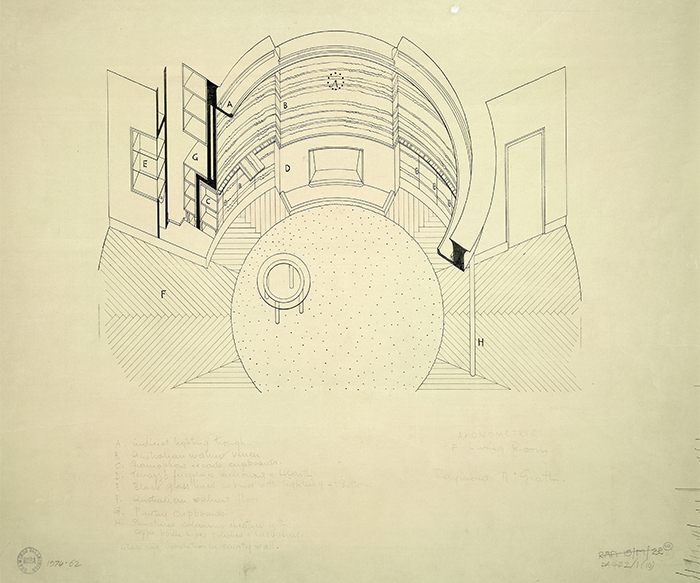
Great Swifts – outing the past from within the RIBA Collections
Internal RIBA LGBTQ+ Community member – Jason C.
The impact of the trial of Oscar Wilde in 1895 loomed large over the first half of the 20th century. Consequently, very few individuals admitted to being openly homosexual for fear of blackmail or imprisonment.
The architect Charles Geddes Clarkson Hyslop (1900-1988), who signed his drawings ‘Geddes Hyslop’ and was known to his friends as ‘Paul,’ lived with the journalist and critic Raymond Mortimer (1895-1980), in Islington, London. His architectural work was varied, ranging from churches, domestic projects, and university buildings as well as a vast amount of work for the National Trust.
Admitted to the RIBA as an Associate Member in 1934, Hyslop became a RIBA Fellow in 1945, and copies of his Fellow Nomination Papers from our institutional archive are on display.
The list of his principal works includes Great Swifts (1938), a new country house in Kent. The client, Victor Cazalet MP (1896-1943), was one of Neville Chamberlain’s ‘Glamour Boys;’ a derisory term the Prime Minister used for a group of gay MPs who opposed his appeasement policy in the late 1930s as they believed war was inevitable.
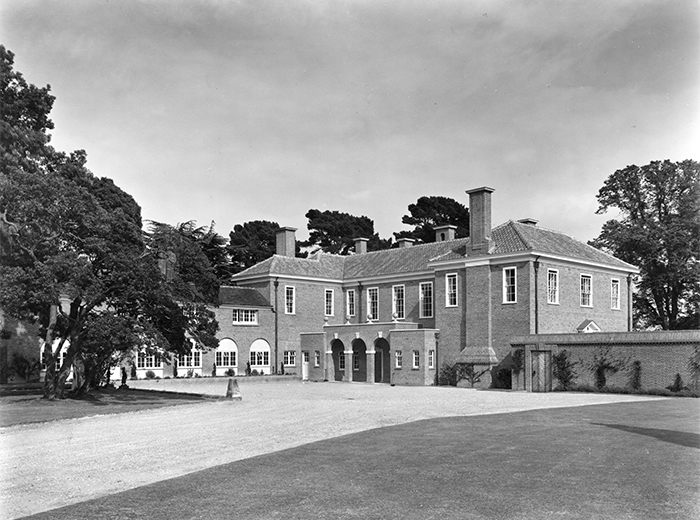
Queer coastlines – growth and development of the seaside
Internal RIBA LGBTQ+ Community member and 2021 Gordon Ricketts Research Fund recipient – Matthew D.
Moving beyond the sweet haze of seaside nostalgia revealed hidden narratives with a rich political history of the labour and union movements which could be seen through its architecture.
While conducting site visits to Blackpool it was clear that the contemporary narrative had shifted, social and political acts are still present one of the most visible acts being explicit signs of queer expression, and pride.
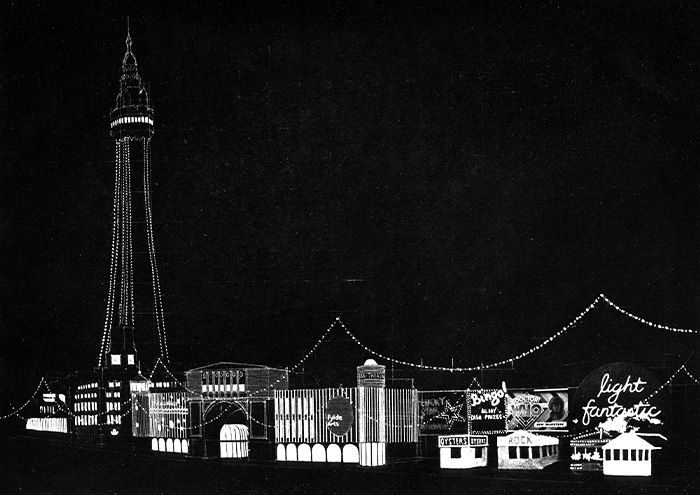
Queer readings in the RIBA Library
When talking of queer public spaces or places where LGBTQ+ people can safely meet, the first picture that comes to mind is that of a gay pub or club, but for the majority, those are only a reality in cities. Moving away from certain geographical or ‘social’ locations, the opportunities to socialise with other LGBTQ+ people are rare or non-existent.
Two prominent articles from the RIBA Collections focus on ‘queer spaces’, the need for them, their political and social values, and for some, their role as life saver.
Queer growth by Joe Crowdy was published in the Architectural review in February 2021 and illustrates Derek Jarman’s garden at Prospect Cottage, Dungeness and Edward Carpenter’s garden at Millthorpe. Despite being conceived a century apart, Jarman bought Prospect Cottage in 1986 and Millthorpe was built in 1883, both places present plenty of similarities and are examples of alternative ways of living in the UK.
Structures of kinship by Marlon Bailey was published in the Architectural Review in March 2021. The article focuses on Ballroom culture in the United States. Beginning in the late 1960s in Harlem, New York. Ballroom culture (referred to also as House) is a Black and Latinx LGBTQ+ cultural formation and is considered an alternative family, where members of the community can find the type of care and support they cannot find in their families and communities of origin. In recent years the Ballroom community has gone global.
Illustrating a scenario set in different geographical and cultural locations, and in different times in history, these two articles highlight the need for LGBTQ+ people to find places where they can express themselves ‘normally,’ meaning according to their nature, without being arrested, beaten, bullied, or murdered. Those places have been and will continue to be a refuge for the present while also symbolising hope for the future.
Check out our RIBA Collections research guide to see other LGBTQ+ items within our collections.
This exhibition was originally on display at the RIBA Library at 66 Portland Place for LGBT+ History Month, February 2023 and at RIBA North in Liverpool as part of the Eurovision Pride House Liverpool programme in May 2023.






